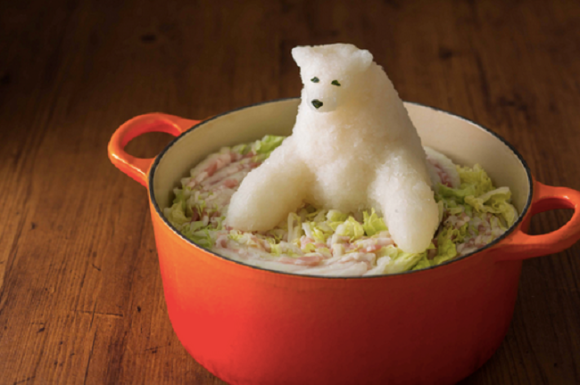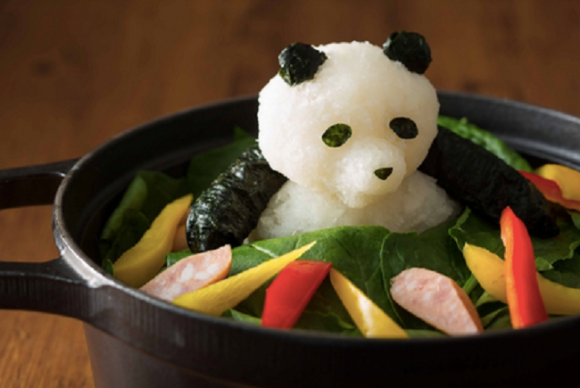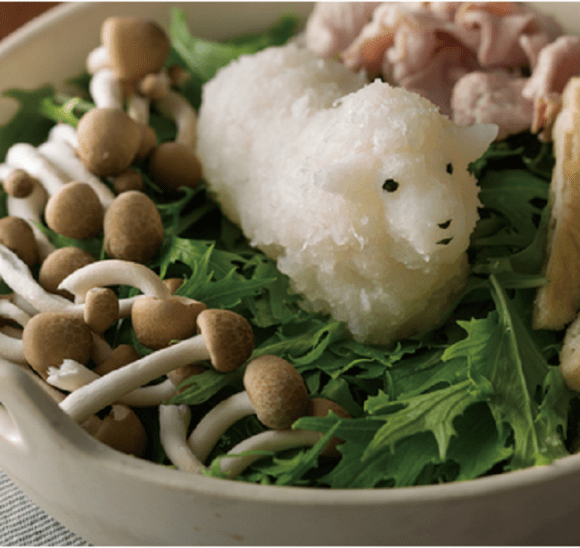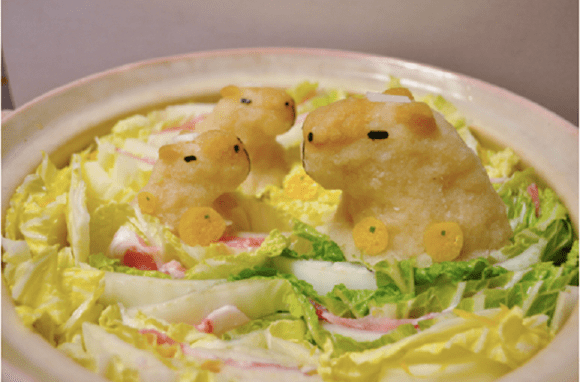
Japan’s become pretty enamored with latte art over the past few years, with baristas all over the country creating cute characters in swirls of cream and foam. But what if you’re not a coffee drinker, either because you’re watching your caffeine intake or just because your inner child won’t let you drink anything so bitter? Is there a way for you to set your table with eye-pleasing edibles?
Sure there is! All you need is a pile of grated daikon radish, and this new book that tells you how to craft it into adorable edibles.
As one of Japan’s most widely grown domestic vegetables, there are a number of ways to prepare daikon. Just about the simplest is daikon oroshi, or grated daikon. A dollop of it is often added to grilled fish, but daikon oroshi also gets tossed into nabe hotpots pretty regularly, something more and more people are looking to eat now that the weather is getting colder.
The texture of daikon oroshi is fine enough that it’s ordinarily shapeless, but still malleable if you want to build something out of it. While growing up, many of us were told not to play with our food, but I’m guessing we didn’t have quite the mix of culinary and artistic skills as daikon oroshi artist Kimimarokku.
One of the medium’s pioneers, Kimimarokku’s work features prominently in the simply titled Daikon Oroshi Art, which explains the fundamentals for newcomers to the hobby. Kimimarokku contributed 10 pieces to the printed collection, including the polar bear seen above that was her first big hit and caused a sensation when she shared it on Twitter.
Kimimarokku says she was inspired to make the daikon oroshi for the birthday party of a polar bear-loving friend. The artist also has a younger sister who’s especially fond of pandas, so you know what that means.
She’s gotten so skilled that she’s moved on from just creating the animals themselves, and has even starting turning her hotpots into mini dioramas. Here, we see a fluffy sheep strolling along a forest path of mizuna herbs next to a grove of mushrooms.
You don’t even have to limit yourself to animals with pure white coats. By mixing in a little ginger to add some color, Kimimarokku was able to produce what might be her cutest creation yet, a family of capybaras relaxing in a bath with yuzu citrus fruits bobbing about.
While Kimimarokku is the star of the book, she’s not the sole focus, as it contains 32 entries from other individuals and even companies, such as miso maker Marukome, which made this radish version of its Marukome-kun corporate mascot.
Daikon Oroshi Art goes on sale this month at bookstores for 900 yen (US $8.25). Pick up a copy and find your own answer to the question, “Does it still count as playing with your food when you end up with a work of art?”
[ Read in Japanese ]






 Grated radish art from Japan brings the cute to your favourite dishes
Grated radish art from Japan brings the cute to your favourite dishes In Japan, capybaras not only bathe in hot springs, they swim in your soup
In Japan, capybaras not only bathe in hot springs, they swim in your soup Beat the heat with these 14 adorable daikon dishes!
Beat the heat with these 14 adorable daikon dishes! Japanese cook creates adorable meal of “cats” feasting on fish!
Japanese cook creates adorable meal of “cats” feasting on fish! Pokemon radish discovered in Japan, just as cute as the original
Pokemon radish discovered in Japan, just as cute as the original McDonald’s new Happy Meals offer up cute and practical Sanrio lifestyle goods
McDonald’s new Happy Meals offer up cute and practical Sanrio lifestyle goods All-you-can-drink Starbucks and amazing views part of Tokyo’s new 170 meter-high sky lounge
All-you-can-drink Starbucks and amazing views part of Tokyo’s new 170 meter-high sky lounge McDonald’s Japan releases a pancake pie for new retro kissaten coffeeshop series
McDonald’s Japan releases a pancake pie for new retro kissaten coffeeshop series Starbucks reopens at Shibuya Scramble Crossing with new look and design concept
Starbucks reopens at Shibuya Scramble Crossing with new look and design concept Studio Ghibli glasses cases let anime characters keep an eye on your spectacles
Studio Ghibli glasses cases let anime characters keep an eye on your spectacles Beautiful Sailor Moon manhole cover coasters being given out for free by Tokyo tourist center
Beautiful Sailor Moon manhole cover coasters being given out for free by Tokyo tourist center More foreign tourists than ever before in history visited Japan last month
More foreign tourists than ever before in history visited Japan last month Super Nintendo World expansion gets delayed for several months at Universal Studios Japan
Super Nintendo World expansion gets delayed for several months at Universal Studios Japan Hamster abandoned at Tokyo ramen restaurant gets new home
Hamster abandoned at Tokyo ramen restaurant gets new home Expensive Japanese nail clippers: Are they worth it?
Expensive Japanese nail clippers: Are they worth it? Disney princesses get official manga makeovers for Manga Princess Cafe opening in Tokyo
Disney princesses get official manga makeovers for Manga Princess Cafe opening in Tokyo Beautiful new Final Fantasy T-shirt collection on the way from Uniqlo【Photos】
Beautiful new Final Fantasy T-shirt collection on the way from Uniqlo【Photos】 Is the new Shinkansen Train Desk ticket worth it?
Is the new Shinkansen Train Desk ticket worth it? Foreign English teachers in Japan pick their favorite Japanese-language phrases【Survey】
Foreign English teachers in Japan pick their favorite Japanese-language phrases【Survey】 Japanese convenience store packs a whole bento into an onigiri rice ball
Japanese convenience store packs a whole bento into an onigiri rice ball We try out “Chan Ramen”, an underground type of ramen popular in the ramen community
We try out “Chan Ramen”, an underground type of ramen popular in the ramen community Studio Ghibli releases Kiki’s Delivery Service chocolate cake pouches in Japan
Studio Ghibli releases Kiki’s Delivery Service chocolate cake pouches in Japan Japan’s bone-breaking and record-breaking roller coaster is permanently shutting down
Japan’s bone-breaking and record-breaking roller coaster is permanently shutting down New definition of “Japanese whiskey” goes into effect to prevent fakes from fooling overseas buyers
New definition of “Japanese whiskey” goes into effect to prevent fakes from fooling overseas buyers Our Japanese reporter visits Costco in the U.S., finds super American and very Japanese things
Our Japanese reporter visits Costco in the U.S., finds super American and very Japanese things Studio Ghibli unveils Mother’s Day gift set that captures the love in My Neighbour Totoro
Studio Ghibli unveils Mother’s Day gift set that captures the love in My Neighbour Totoro Foreign passenger shoves conductor on one of the last full runs for Japan’s Thunderbird train
Foreign passenger shoves conductor on one of the last full runs for Japan’s Thunderbird train Domino’s Japan now sells…pizza ears?
Domino’s Japan now sells…pizza ears? New Japanese KitKat flavour stars Sanrio characters, including Hello Kitty
New Japanese KitKat flavour stars Sanrio characters, including Hello Kitty Kyoto creates new for-tourist buses to address overtourism with higher prices, faster rides
Kyoto creates new for-tourist buses to address overtourism with higher prices, faster rides Sales of Japan’s most convenient train ticket/shopping payment cards suspended indefinitely
Sales of Japan’s most convenient train ticket/shopping payment cards suspended indefinitely Sold-out Studio Ghibli desktop humidifiers are back so Totoro can help you through the dry season
Sold-out Studio Ghibli desktop humidifiers are back so Totoro can help you through the dry season Japanese government to make first change to romanization spelling rules since the 1950s
Japanese government to make first change to romanization spelling rules since the 1950s Ghibli founders Toshio Suzuki and Hayao Miyazaki contribute to Japanese whisky Totoro label design
Ghibli founders Toshio Suzuki and Hayao Miyazaki contribute to Japanese whisky Totoro label design Doraemon found buried at sea as scene from 1993 anime becomes real life【Photos】
Doraemon found buried at sea as scene from 1993 anime becomes real life【Photos】 Tokyo’s most famous Starbucks is closed
Tokyo’s most famous Starbucks is closed One Piece characters’ nationalities revealed, but fans have mixed opinions
One Piece characters’ nationalities revealed, but fans have mixed opinions We asked a Uniqlo employee what four things we should buy and their suggestions didn’t disappoint
We asked a Uniqlo employee what four things we should buy and their suggestions didn’t disappoint Princesses, fruits, and blacksmiths: Study reveals the 30 most unusual family names in Japan
Princesses, fruits, and blacksmiths: Study reveals the 30 most unusual family names in Japan Are 100 yen shop Daiso’s Japanese radish seeds worth your time? Let’s find out【Experiment】
Are 100 yen shop Daiso’s Japanese radish seeds worth your time? Let’s find out【Experiment】 Learn to love the taste of raw daikon with this simple recipe 【RocketKitchen】
Learn to love the taste of raw daikon with this simple recipe 【RocketKitchen】 Vegetables are smarter than fruits: Three high IQ Japanese veggies
Vegetables are smarter than fruits: Three high IQ Japanese veggies Adorable character hot pots are this fall’s kawaii-est foods
Adorable character hot pots are this fall’s kawaii-est foods Never work with animals: Outtakes from Japanese delivery company’s adorable black cat ad【Video】
Never work with animals: Outtakes from Japanese delivery company’s adorable black cat ad【Video】 Can you guess the most-consumed vegetable in Japan? This survey reveals the results
Can you guess the most-consumed vegetable in Japan? This survey reveals the results Try a super-easy summer cold remedy with this natural Honey Daikon Cough Syrup recipe
Try a super-easy summer cold remedy with this natural Honey Daikon Cough Syrup recipe World’s largest type of daikon radish can now be ordered online in Japan
World’s largest type of daikon radish can now be ordered online in Japan How to turn a classic Japanese noodle dish into Studio Ghibli’s Totoro
How to turn a classic Japanese noodle dish into Studio Ghibli’s Totoro Taiwanese cafe fulfills customer requests with amazingly accurate 3-D custom latte art
Taiwanese cafe fulfills customer requests with amazingly accurate 3-D custom latte art Japanese actress wows in stunning edible dress made of vegetable slices【Video】
Japanese actress wows in stunning edible dress made of vegetable slices【Video】 Japanese convenience store food takes a walk on the weird side with…cup pork?
Japanese convenience store food takes a walk on the weird side with…cup pork? Agedashi…doughnuts? Traditional Japanese tofu dish gets a sweet twist from Mister Donut
Agedashi…doughnuts? Traditional Japanese tofu dish gets a sweet twist from Mister Donut Check out these super-ultra-teeny-tiny bonsai! 【Photos】
Check out these super-ultra-teeny-tiny bonsai! 【Photos】 Which Japanese convenience store has the best miso vegetable stick pack?【Taste test】
Which Japanese convenience store has the best miso vegetable stick pack?【Taste test】
Leave a Reply